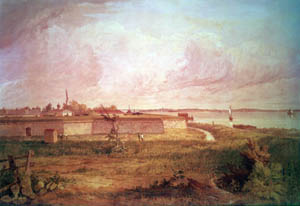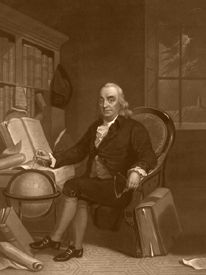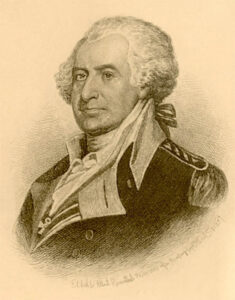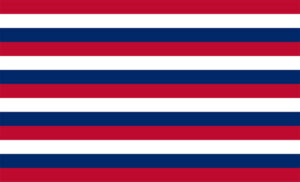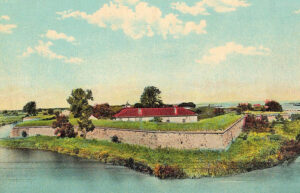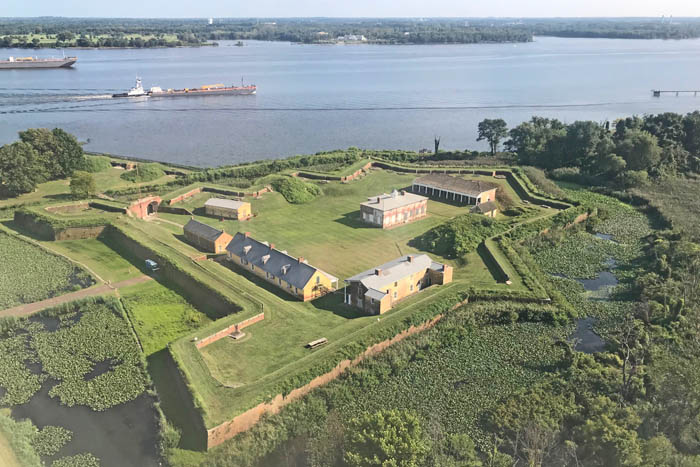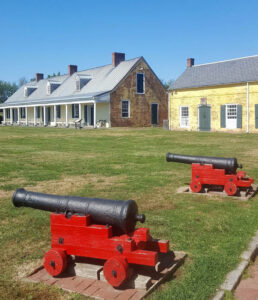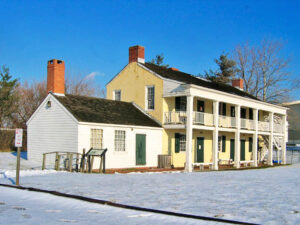Fort Mifflin was first called Fort Island Battery on the Delaware River below Philadelphia, Pennsylvania. Also known as Mud Island Fort, it was commissioned in 1771.
By the 1740s, the site ranked as the wealthiest British port in the New World. French and Spanish privateers entered the Delaware River then, threatening the city. During King George’s War between 1744 and 1748, Benjamin Franklin raised a militia because the city’s legislators, most of whom were Quakers, opposed military engagement and refused to defend Philadelphia “either by erecting fortifications or building Ships of War.” Franklin raised money to create earthwork defenses and to buy artillery. At the war’s end, commanders disbanded the militia and left the city’s defenses derelict.
With renewed colonial warfare in the 1750s, especially the French and Indian War, plans were drawn up for a fort on Mud Island, but no fort was built.
By 1771, Philadelphia ranked as North America’s largest British port and dockyard. Locals then rose in protest against British economic policies and imports. In response to complaints by the Secretary of State for the Colonies, Pennsylvania Governor John Penn asked General Thomas Gage to send someone capable of designing defenses for the city. He intended to have a fort on Mud Island (also known as Deep Water Island) to help regulate traffic entering and exiting the port. Gage assigned Captain John Montresor of the British Corps of Engineers to the task. Montresor presented six designs to Penn and the Board of Commissioners; the board proposed constructing a fort on Mud Island.
The commissioners reviewed the plans and found them too expensive, despite Montresor’s protests about the budget. Montresor stated that his preferred plan cost about £40,000 and intended to mount “32 pieces of cannon, four mortars and four royal howitzers… which at six men each make 240 men required, 160 musketries, in all 400 garrisons.” The Colonial Provincial Assembly passed a bill releasing £15,000 for the fort’s construction and the purchase of Mud Island. The board instructed Montresor to begin construction but failed to provide him with the funds he considered necessary to do so correctly.
On June 4, 1772, Montresor left the head workman in charge of the construction project and returned to New York disgruntled. The project floundered for about a year before stopping due to a lack of guidance and funding. The crews completed only the stone east and south walls.
Following adopting the Declaration of Independence, Benjamin Franklin headed a committee to defend Philadelphia’s revolutionary capital. The Philadelphia Committee of Public Safety soon restarted construction on the fort, which was finally completed in 1776. The committee also simultaneously built Fort Mercer in New Jersey on the eastern bank of the Delaware River across from Fort Mifflin. The Americans intended to use Fort Mifflin and Fort Mercer to control the activity of the British Navy on the Delaware River, guarding against General Howe and Admiral Reynolds’ advanced naval fleet.
Defenders of Philadelphia assembled and placed obstacles in tiers spanning the width of the Delaware River between Forts Mercer and Mifflin. These defenses comprised wooden-framed “boxes” that were 30 feet square, constructed of massive timbers, and lined with pine planks. Defenders lowered the frames onto the riverbed and filled each with 20 to 40 tons of stone to anchor them in place. They placed two or three large timbers tipped with iron spikes into each frame, set underwater and facing downstream. They then chained the boxes together to maintain continuity. These defenses presented a formidable obstacle that could impale unwitting ships. The system’s design included gaps to allow passage of friendly shipping. However, only a select few patriot navigators knew the locations of safe passage through this barrier. Soldiers at Forts Mercer and Mifflin could fire at anyone attempting to dismantle these obstacles.
After General George Washington’s defeat at the Battle of Brandywine, the British took control of Philadelphia in September 1777. The British forces then laid siege to Fort Mifflin and Fort Mercer in early October 1777, unsuccessfully attacking the latter by land and river in the Battle of Red Bank on October 22. The British intended the siege to open its supply line via the Delaware River. Captain John Montresor, earlier designer and constructor of Fort Mifflin, planned and built the siege works against Fort Mifflin. He then led the siege and destroyed much of the fort. During the siege, 400 American soldiers held off more than 2,000 British troops and 250 ships until November 10, 1777, when the British intensified their assault, launching a constant barrage of cannonballs into the fort. Among those stationed at the fort was Private Joseph Plumb Martin, who later wrote an account of the battle.
Defending the riverway, Commodore John Hazelwood, with a sizable fleet of galleys, sloops, and fire vessels, launched several raids on British positions on shore, constantly harassing British river operations while patrolling the waters around the fort. On November 15, 1777, the American troops evacuated the fort. Their stand effectively denied the British Navy free use of the Delaware River. It allowed the successful repositioning of the Continental Army for the Battle of White Marsh and subsequent withdrawal to Valley Forge. Fort Mifflin experienced the heaviest bombardment of the American Revolution. The siege left 250 of the more than 400 men garrisoned at Fort Mifflin killed or wounded. Comrades-in-arms ferried these dead and wounded to the mainland before the final evacuation. Fort Mifflin never again saw military action.
The ruins of Fort Mifflin lay derelict until 1793, when rebuilding began under what was later called the first system of U.S. coastal fortifications. In 1794, Pierre L’Enfant, also responsible for planning Washington, D.C., supervised the reconstruction, including the design and rebuilding of the fort. Reconstruction began on the fort in 1795 under engineer officer Louis de Tousard, who, from 1795 to 1800, traveled along the coast between Massachusetts and the Carolinas, working on coastal defenses. The initial goal was to rebuild the fort to accommodate 48 guns.
The buildings at Fort Mifflin included two-story barracks for soldiers in the 1790s, measuring 117 feet by 28 feet. The original barracks contained seven rooms, five designed to house 25 men. The army officially named the fort after Major General Thomas Mifflin, a Continental Army officer and the first post-independence Governor of Pennsylvania, in 1795.
Over a cross-shaped hole in the ground previously designated as a last-ditch defensive area near the center of the fort, the army built the extant citadel structure to house the commandant in 1796.
Lieutenant Colonel Stephen Rochefontaine replaced Pierre Charles L’Enfant as chief engineer at Fort Mifflin in 1798 and completed the citadel structure to house the commandant. Lieutenant Colonel Rochfontaine used and improved the original designs of L’Enfant. The Commandant’s House exemplifies Greek Revival architecture, which is rare on Army installations in the United States. The army also built the six cavelike casemates as defensive structures in the case of an enemy siege during the reconstruction of 1798-1801. Soldiers used a “bake oven” just inside the main gate and the entrance to the bomb-proof casemate for baking bread, as a chapel, and as a mess hall.
Rebuilding the fort consumed $94,000 of a total fort budget of $278,000 in 1798 and 1799 alone. U.S. Congress met in Philadelphia until 1800, and Fort Mifflin was well garrisoned until then, usually with two companies.
The army built the blacksmith shop before 1802, probably the oldest surviving complete structure at Fort Mifflin.
In 1808, Fort Mifflin was repaired due to the 1807 Second System Plan.
In the 1811 annual report of the Secretary of War, Fort Mifflin was described as “…mounting 29 heavy guns, with a water battery without (outside) the works, mounting eight heavy guns… with brick barracks for 100; within 3/4 of a mile… (is) the Lazaretto, which are good barracks for 400 men.”
In 1814, a two-story officers’ quarters measuring 96 feet by 28 feet was built.
The U.S. Army built a one-story brick structure, 24 feet by 44 feet, in 1815-1816 as a guardhouse and prison. In about 1819, north of the fort’s walls, the army also built a two-story building that housed a hospital on the second floor and a mess hall on the ground floor.
Fort Mifflin was relegated to secondary status after the construction of Fort Delaware in 1820. During the 19th century, the area around the fort was drained and filled until Mud Island connected with the western bank of the Delaware River. Nevertheless, the building and garrisoning of Fort Mifflin continued. In the early 1820s, the army began meteorological observations at the fort.
The soldiers’ barracks building and the officers’ quarters were extensively renovated in 1836. Later, the soldiers’ barracks were again renovated, and the roofline was changed to add the second floor. In 1837, the hospital and mess hall building was converted to a meetinghouse, and an artillery shed for the storage and protection of cannons was built on an interior raised platform.
By 1839, the army designated the one-story brick guardhouse prison as an arsenal.
During the 1840s, a two-story kitchen wing was added to the officers’ quarters building.
On December 27, 1842, the army completed a brick, one-story sutler building/storehouse measuring 55 feet by 20 feet.
During the Civil War, the Union used Fort Mifflin to house Confederate prisoners of war, as well as Union soldiers and civilian prisoners. Numerous Confederate prisoners occupied Fort Mifflin from 1863 to 1865 and were housed in Casemate #1. The Union Army used three smaller casemates to hold political prisoners during the same period. During that time, the fort had a maximum prisoner capacity of only 250, but the most it housed at one time was 215. There were 42 escapes and three prisoner deaths recorded.
The Union Army accused William H. Howe, one of its soldiers, of desertion, found him guilty of murder, and imprisoned him famously at Fort Mifflin from January 1864. Howe led an attempted escape of 200 prisoners from Casemate #5 in February 1864. Afterward, Howe was housed in a solitary confinement cell in Casemate #11, where he left his signature. Despite his illiterate reputation, Howe twice wrote letters (filled with bad grammar and run-on sentences) to President Abraham Lincoln, asking for clemency and signing them with his own hand. In April 1864, Howe was transferred to Eastern State Penitentiary but was transferred back to Fort Mifflin on August 26 of the same year. The condemned prisoner was briefly held in the fort’s wooden guardhouse before his execution on the gallows, which were steps away from the guardhouse. Howe’s hanging was before an audience of people who paid for tickets to watch the execution. Of the three other men executed at Fort Mifflin, none had a paid public audience.
On November 24, 1864, the Union Army sent Lieutenant Colonel Seth Eastman, the American Western frontier painter, to Fort Mifflin to supervise the discharge of all civilian and military prisoners, then numbering more than 200. On January 2, 1865, Eastman reported that his garrison consisted of B Company, 186th Pennsylvania Volunteer Regiment, a detachment of recruits, and the hospital staff.
On August 20, 1865, Captain Thomas E. Merritt relieved Lieutenant Colonel Eastman with A Company of the 7th United States Veteran Volunteers. The army completed the West sally port by 1866, and the same year, the 7th United States Veteran Volunteers vacated the fort. The District Engineer Office, Corps of Engineers, replaced the company. The fort passed in and out of use several times in its subsequent history.
Between 1866 and 1876, the Corps of Engineers intermittently repaired and modernized Fort Mifflin and upgraded its armament. The army worked on the detached high battery south of the fort from 1870 to 1875 but never finished it. The army also built a torpedo casemate in 1874-1875. Today, Casemate #11″, preserves a trove of historical artifacts. These artifacts include pottery, a tin cup, a tin chamber pot, period buttons, and dozens of animal bones.
From 1876 to 1884, the Philadelphia District Office of the Corps of Engineers took custodial responsibility for Fort Mifflin. The east magazine (torpedo casemate) first appeared on a map in 1886. During World War I, the fort was used to store munitions.
The old fort was disarmed and partially dismantled in 1904.
The fort was designated a National Historic Landmark in 1915. The army removed the two-story kitchen wings from the officers’ quarters building sometime before the 1920s.
The fort was restored from the original plans in 1930.
During World War II, the U.S. Army stationed anti-aircraft guns at Fort Mifflin to defend the nearby Fort Mifflin Naval Ammunition Storage Depot and the Philadelphia Naval Shipyard. Marine Corps units from the naval shipyard guarded the Naval Ammunition Storage Depot at the northern end of the former Mud and Cabin Islands, and the U.S. Army assigned troops to defend the fort. In April 1942, the U.S. Army stationed Battery H of the 76th Coast Artillery Regiment, the first African American Coast Artillery unit in U.S. military history, at the fort. On May 24, 1942, the 76th Regiment was relieved and moved to California to prepare for overseas deployment, and the U.S. Army stationed the 601st Coast Artillery Regiment at Fort Mifflin.
In 1954, Fort Mifflin was decommissioned as an active military post. It closed, ranking among the oldest forts in continuous use in the nation’s history. The fort’s interior was renovated in 1960. The U.S. Army decommissioned Fort Mifflin for active duty infantry and artillery in 1962. At that time, the federal government deeded Fort Mifflin to the City of Philadelphia.
In 1969, architect John Dickey restored the Blacksmith Shop’s bellows and forge.
In the late 1970s, the Commandant’s House at the Fort was destroyed by an accidental fire started by camping Boy Scouts.
In the 1980s and early 1990s, Harold Finigan, the fort’s executive director, worked with architects to restore the fort’s artillery shed, hospital, mess hall, officers’ quarters, kitchen wings, arsenal, soldiers’ barracks, north and west sally ports, and seawall and to construct a bridge over the moat at the fort’s main gate. During restoration, it was determined that the exterior of the buildings had been yellow-washed during the Civil War era.
The two-story kitchen wings were restored in the early 1990s as part of a significant restoration of the building.
In 2006, Wayne Irby rediscovered and unearthed the recently named Casemate #11 at Fort Mifflin. In August of that year, Dr. Don Johnson and a small group of volunteers uncovered and rediscovered the complexity of the fort’s inner rooms and a trove of historical artifacts inside Casemate #11.
Fort Mifflin remains an active base for the U.S. Army Corps of Engineers. It is currently the oldest active U.S. military base and the only base predating the Declaration of Independence.
Only the white stone walls of the original Fort Mifflin survive today. The pockmarks in these stone walls evidence the intensity of the British bombardment of 1777. The standing buildings that remain today are the Arsenal, Artillery Shed, Blacksmith Shop, Sutler Building/Storehouse, Soldiers’ Barracks, Officers’ Quarters, Commandant’s House, Hospital/Messhall, West Sallyport, Casemates, East Magazine, and Casemate #11. Today, the site is a National Historic Landmark and offers grounds tours.
Comprising 84 acres, the site is bounded on the south by the Philadelphia International Airport, to the north by the airport and the Corps of Engineers, on the east by the Corps of Engineers, and on the south by the Delaware River. The City of Philadelphia owns it.
©Kathy Alexander/Legends of America, updated March 2024.
Also See:
Forts & Presidios Across America
Philadelphia, Pennsylvania – Independence Begins
Sources:
American Battlefield Trust
Fort Wiki
Historic American Building Survey
Wikipedia


